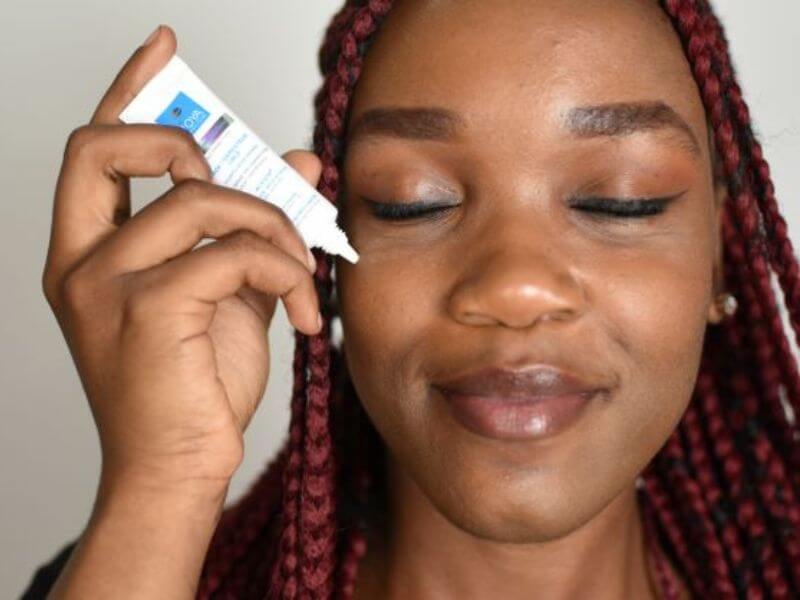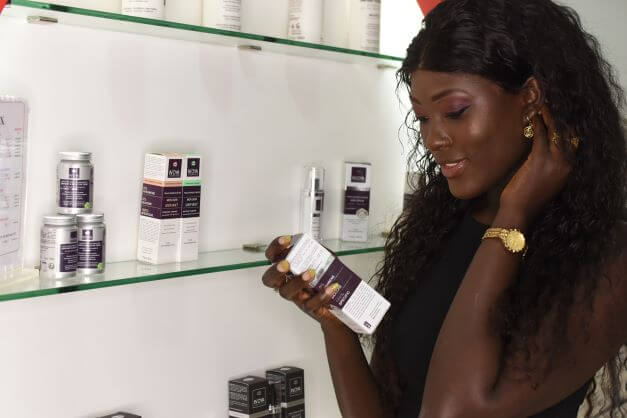Pimples, blackheads, oily skin... These imperfections due to acne generally present on the face and upper body represent a real suffering. Moreover, for dark skin, black or mixed race skin, the difficulties of healing and hyperpigmentation accentuate this dermatological problem.
Therefore, among these people who have managed to regain a healthy skin, a great discomfort remains. The stigma of this skin condition remains visible. Despite a matte appearance and the absence of pimples, they are unable to recover a smooth touch and a unified complexion. Dark spots and unsightly marks, either hollowed out or raised, prevent them from having beautiful, clear skin.
Can acne scars really be reduced or even erased without risk? From pigmentary spot to the deep mark, In'Oya explains how to fade and accelerate their disappearance.
ACNE SCARRING: A HIGH-RISK PROCESS FOR RISK FOR BLACK SKIN
The post-acne scar is a particular type of residual mark. It is formed during the reconstruction of the skin following a pimple. Black skin is particularly sensitive to this problem. They are, in fact, affected by both oily skin with a tendency to acneic skin and a delicate healing mechanism. This is why their treatment is often multiple treatments.
During the evolution of an acne pimple, the risk of scars and spots is much greater than for white skin. The probability of developing a complex scar, such as a keloid scarring is also more likely.
An acne scar is the consequence of an inflammatory lesion. For these sensitive epidermis, healing a comedo is therefore a delicate process. Because the reconstitution of the skin, a fundamental step in this natural process, does not always take place correctly.
First of all, since the healing of black or dark skin leads to an excessive production of melanin of melanin, the risk of hyperpigmentation automatically increases. Secondly, in some cases of severe acne - nodular acne, cystic acne - there is often an abnormality of scarring.
In place of the pimple, granulation tissue may form on the surface in an irregular manner from collagen fibers. Sometimes, on the contrary, the lesion will evolve by digging into the skin surface. From then on, the post-acne scar constitutes an unsightly mark, more or less visible.
In this simultaneous context of hyperpigmentation and acne scars, the two problems are often confused. Dermatologists specializing in black skin frequently observe this. This is why, in the case of acne, they recommend distinguishing between spots and scars.
DISTINGUISH PIGMENT SPOTS DUE TO PIMPLES FROM DEEP ACNE SCARS
Pigmented pimple scars are superficial
The spot is sometimes referred to as a pigmentary acne scar, because its appearance is the result of the scarring of a pimple. But without texture, unlike scar tissue, this residual mark has no relief : only the color of the skin is modified.
This superficial change does not alter its structure in depth. Therefore, this light scarring, frequent in post-sun acne, can be faded with a targeted treatment. However, the reconstitution of cells in darker skin types takes longer than in lighter skin types.
A specific skin care routine and a certain amount of patience are therefore necessary to results. It usually takes several weeks, even months, to get a clear and unified skin.
Complex acne scars: atrophic, hypertrophic, keloids
A real acne scar, on the other hand, is difficult to remove. This type of unsightly mark unsightly mark, in hollow or in relief, is frequent in cases of inflammatory acne, even painful acne such as nodulocystic acne. It is often a serious problem for sufferers.
There are 3 categories of acne scars, resulting from an abnormality in the reconstruction of the skin: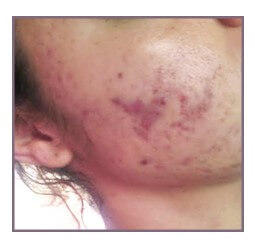
- Atrophic scarring: the surface of the skin is as if hollowed out. The connective tissue reconstituted by the epidermis is insufficient to fill the cavity following the acne pimple. Dermatologists call this small, deep, narrow crater "the ice pick scar".
- Hypertrophic scar: as a result of the inflammatory lesion, a more or less large mass has formed during the cellular repair mechanism. Depending on the skin phototype, a red, purplish or brown mark can be seen. Over time, this fibrous tissue can be smoothed out, but only after several years.
- Post-acne keloid scar: originally hypertrophic, its evolution is similar to a mini-cyst. Swollen, this unsightly scar swells without spontaneous regression.
It extends beyond the initial lesion and is often itchy and even painful. These lesions are not serious, however, they are at the origin of a loss of self-confidence, even a malaise.
SOLUTIONS TO GET RID OF SCARS AND POST-ACNE SCARS AND SPOTS
The treatment of deep acne scars requires the intervention of medical professionals. On the other hand, in the case of hyperpigmentation resulting from pimples, the skin is only affected on the surface. A targeted anti-spot strategy can therefore erase and avoid these acne scars.
Treatment of deep post-acne scars by a health professional
Deep acne scars should be treated by a dermatologist, preferably one who specializes in the care of dark dermatologist, preferably specialized in the care of dark skin. He or she will propose, upon diagnosis, one or more methods to attenuate the scars resulting from acne.
Compatible with the specificities of pigmented skin, they will not present any risk post-intervention.
Here are two examples: microneedling and laser.
MICRONEEDLING TECHNIQUE TO ERASE ACNE SCARS
Microneedling is a technique based on the use of micro-needles that is very effective in reducing the visibility of scars. It consists of treating the injured area with a special electric pen, special needling pen. This will create small perforations to cause a process of healing process. The production of collagen is stimulated to result in a resurfacing of the skin.
For this approach, always make sure to contact an experienced health care professional. With knowledge of darker skin types, he or she will master the technique in this specific context, in order to avoid any irritation or even hyperpigmentation.
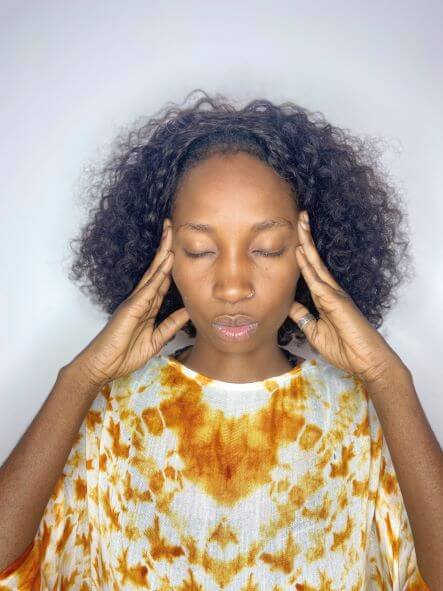
LASERS & RESURFACING: SAFE TO TREAT ACNE SCARS ACNE SCARS IN DARKER SKIN?
Lasers, also used for hyperpigmentation, are indicated to fade acne scars on dark skin. However, it is recommended to be cautious before turning to these practices.
On the one hand, some lasers are not made to properly meet the needs of black, dark or mixed race skin. On the one hand, some lasers are not made to meet the needs of black, dark or mixed skin and even represent a danger. On the other hand, treatments for certain scars, such as keloids, do not include this procedure.
The abrasive laser removes the superficial layers of the skin to induce regeneration. But it exposes darker skin to a high risk of permanent depigmentation. From now on, there is a new technology completely adapted to the acne scars of these sensitive skins: the fractional laser.
By creating multiple non-contiguous impact points, this procedure offers an optimal result, without danger, with result, without danger, with light after-effects. This approach is also used to remove tattoos and effectively regenerates black or matte skin, in complete safety. Non-invasive, it naturally stimulates collagen production and significantly refines the skin's texture.
Only a physician can accurately assess the possibility of fading an acne scar with a laser. Moreover, in the case of pigmented skin, a mastery of their specificities is to avoid complications.
This is why, before scheduling an operation, it is preferable to consult a dermatologist specializing in black, dark or mixed skin. The professional will be able to establish a diagnosis of your acne scars. In a second step, he will present you with the medical solutions to consider, laser or other protocols, and their cost.
Targeted care routine: fade light scars and spots due to pimples
To promote the disappearance of superficial post-acne marks on black skin, the combination of anti-acne and anti-spot treatments must be carried out in concert. A routine based on the synergy of active ingredients will support the repair and regeneration functions of the epidermis. Together, they naturally improve the skin's reconstruction process.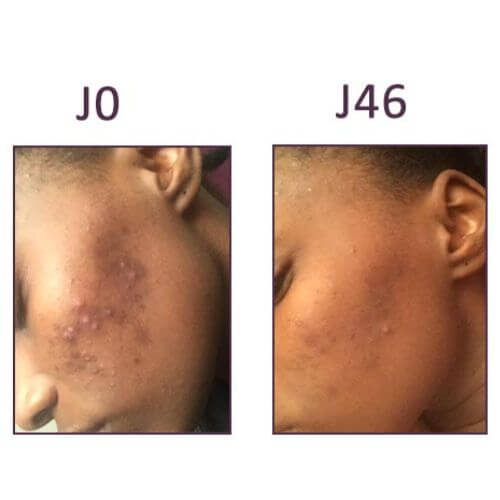
Results obtained with a personalized In'Oya skincare routine
In order to fade residual marks, but also to prevent their appearance, you will treat the causes of acne and its consequences:
- Remove impurities and makeup from your skin twice a day. Cleanse it thoroughly, but always gently. You can alternate the formula between the morning and the evening with a specific solution: foam, micellar water or gel.
- Moisturize your face with a cream adapted to the needs of pigmented skin with acne-prone skin. The purifying active ingredients will regulate sebaceous secretions without the epidermis.
- Before going to bed, you can replace or complete it with a soothing and repairing night care, enriched in hyaluronic acid. Its deep action will boost the natural process of cutaneous regeneration.
- If the pimple is still inflamed, opt for a targeted anti-imperfection corrector to avoid superinfection.
- To fade pigmented acne scars: apply an anti-spot serum adapted to dark skin. Used daily, the repairing effect will act significantly on hyperpigmentation significantly on localized hyperpigmentation. You can optimize this action internally, with a unifying food supplement.
- Don't forget to protect your skin when it is exposed to the sun, with a high sun protection factor. UV rays encourage the appearance of spots and aggravate their development.
Important: a severe form of acne requires medication prescribed by a doctor. This generally consists of a topical application (cream, gel, lotion) possibly completed by an internal treatment (capsule, tablet).
Exfoliation against spots and imperfections: is it effective and safe on pigmented skin?
To support the effectiveness of anti-imperfection and anti-spot care protocols, dermatologists recommend exfoliation, once or twice a week. This topical treatment gently prepares the skin tissue for cell renewal. However, be careful to choose your peel solution carefully, as not all peels are suitable for the sensitivity of darker skin types.
To prevent and treat hyperpigmentation resulting from acne, choose an exfoliating rather than a cosmetic or medical procedure. This approach will respect its specificity and will act effectively on the desquamation of the epidermis.
Make sure that the formula of the chemical and mechanical peeling is in adequacy with the delicate nature of your epidermis. For example, the exfoliating beads must avoid the "micro-scratch" effect that causes irritation. The scrub developed by the In'Oya Laboratory has been designed to safely eliminate dead cells on dark skin. The salicylic acid and glycolic acid present in its composition allow a resurfacing and thus a homogenization of the complexion. The microbeads of Bamboo and Jojoba bring a soft mechanical exfoliation to smooth the skin texture and obtain a clear and bright complexion.
Good to know: this peeling can be used as an attack treatment, once a day, for 10 days. As a complement to a complete routine, it helps to restore a radiant complexion.


